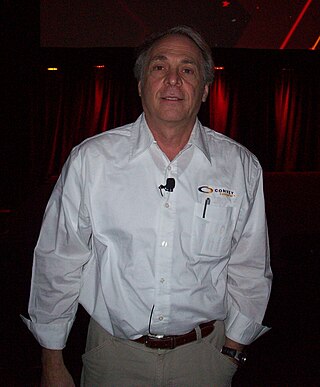
A microprocessor is a computer processor for which the data processing logic and control is included on a single integrated circuit (IC), or a small number of ICs. The microprocessor contains the arithmetic, logic, and control circuitry required to perform the functions of a computer's central processing unit (CPU). The IC is capable of interpreting and executing program instructions and performing arithmetic operations. The microprocessor is a multipurpose, clock-driven, register-based, digital integrated circuit that accepts binary data as input, processes it according to instructions stored in its memory, and provides results as output. Microprocessors contain both combinational logic and sequential digital logic, and operate on numbers and symbols represented in the binary number system.

A minicomputer, or colloquially mini, is a type of smaller general-purpose computer developed in the mid-1960s and sold at a much lower price than mainframe and mid-size computers from IBM and its direct competitors. In a 1970 survey, The New York Times suggested a consensus definition of a minicomputer as a machine costing less than US$25,000, with an input-output device such as a teleprinter and at least four thousand words of memory, that is capable of running programs in a higher level language, such as Fortran or BASIC.

Computer-aided design (CAD) is the use of computers to aid in the creation, modification, analysis, or optimization of a design. This software is used to increase the productivity of the designer, improve the quality of design, improve communications through documentation, and to create a database for manufacturing. Designs made through CAD software help protect products and inventions when used in patent applications. CAD output is often in the form of electronic files for print, machining, or other manufacturing operations. The terms computer-aided drafting (CAD) and computer-aided design and drafting (CADD) are also used.

A microcomputer is a small, relatively inexpensive computer having a central processing unit (CPU) made out of a microprocessor. The computer also includes memory and input/output (I/O) circuitry together mounted on a printed circuit board (PCB). Microcomputers became popular in the 1970s and 1980s with the advent of increasingly powerful microprocessors. The predecessors to these computers, mainframes and minicomputers, were comparatively much larger and more expensive. Many microcomputers are also personal computers. An early use of the term "personal computer" in 1962 predates microprocessor-based designs. (See "Personal Computer: Computers at Companies" reference below). A "microcomputer" used as an embedded control system may have no human-readable input and output devices. "Personal computer" may be used generically or may denote an IBM PC compatible machine.
The 801 was an experimental central processing unit (CPU) design developed by IBM during the 1970s. It is considered to be the first modern RISC design, relying on processor registers for all computations and eliminating the many variant addressing modes found in CISC designs. Originally developed as the processor for a telephone switch, it was later used as the basis for a minicomputer and a number of products for their mainframe line. The initial design was a 24-bit processor; that was soon replaced by 32-bit implementations of the same concepts and the original 24-bit 801 was used only into the early 1980s.

Data General Corporation was one of the first minicomputer firms of the late 1960s. Three of the four founders were former employees of Digital Equipment Corporation (DEC).

John Tracy Kidder is an American writer of nonfiction books. He received the Pulitzer Prize for his The Soul of a New Machine (1981), about the creation of a new computer at Data General Corporation. He has received praise and awards for other works, including his biography of Paul Farmer, a physician and anthropologist, titled Mountains Beyond Mountains (2003).

A superminicomputer, colloquially supermini, is a high-end minicomputer. The term is used to distinguish the emerging 32-bit architecture midrange computers introduced in the mid to late 1970s from the classical 16-bit systems that preceded them. The development of these computers was driven by the need of applications to address larger memory. The term midicomputer had been used earlier to refer to these systems. Virtual memory was often an additional criteria that was considered for inclusion in this class of system. The computational speed of these machines was significantly greater than the 16-bit minicomputers and approached the performance of small mainframe computers. The name has at times been described as a "frivolous" term created by "marketeers" that lacks a specific definition. Describing a class of system has historically been seen as problematic: "In the computer kingdom, taxonomic classification of equipment is more of a black art than a science." There is some disagreement about which systems should be included in this class. The origin of the name is uncertain.

The history of computing hardware starting at 1960 is marked by the conversion from vacuum tube to solid-state devices such as transistors and then integrated circuit (IC) chips. Around 1953 to 1959, discrete transistors started being considered sufficiently reliable and economical that they made further vacuum tube computers uncompetitive. Metal–oxide–semiconductor (MOS) large-scale integration (LSI) technology subsequently led to the development of semiconductor memory in the mid-to-late 1960s and then the microprocessor in the early 1970s. This led to primary computer memory moving away from magnetic-core memory devices to solid-state static and dynamic semiconductor memory, which greatly reduced the cost, size, and power consumption of computers. These advances led to the miniaturized personal computer (PC) in the 1970s, starting with home computers and desktop computers, followed by laptops and then mobile computers over the next several decades.
The PDP-5 was Digital Equipment Corporation's first 12-bit computer, introduced in 1963.

Joseph Thomas West III was an American technologist. West is notable for being the key figure in the Pulitzer Prize winning non-fiction book The Soul of a New Machine.

The Data General Eclipse line of computers by Data General were 16-bit minicomputers released in early 1974 and sold until 1988. The Eclipse was based on many of the same concepts as the Data General Nova, but included support for virtual memory and multitasking more suitable to the small office than the lab. It was also packaged differently for this reason, in a floor-standing case the size of a small refrigerator. The Eclipse series was supplanted by the 32-bit Data General Eclipse MV/8000 in 1980.
The Eclipse MV/8000 was the first in a family of 32-bit minicomputers produced by Data General during the 1980s. Codenamed Eagle during development, its architecture was a new 32-bit design backward compatible with the previous 16-bit Eclipse series. The development of the computer and the people who worked on it were the subject of Tracy Kidder's book The Soul of a New Machine. The MV/8000 was succeeded by the MV/6000, MV/8000-II, MV/2000, MV/2500, MV/4000, MV/10000, MV15000, MV/20000, MV/30000 and MV/40000. Later models such as the MV/40000 were SMP systems with hot-swappable components.

Steven "Steve" J. Wallach is an engineer, consultant and technology manager. He is a Seymour Cray Computer Engineering Award recipient.

Epoch Systems Inc., founded in December 1986, was a hardware and software company providing Hierarchical Storage Management (HSM) file servers, and distributed storage management and data backup software. The company was founded by Ken Holberger, Chuck Holland, and Gregory Kenley. Holberger and Holland had worked together as part of the Eagle project described in The Soul of a New Machine. Kenley was a software engineer with expertise in operating systems and storage management. The company began in Marlboro MA and eventually moved to Westborough MA.

The biographical book, The ultimate entrepreneur: the story of Ken Olsen and Digital Equipment Corporation, chronicles the experiences of Ken Olsen racing to design minicomputers at the company of his own founding, Digital Equipment Corporation. At the time the book was published by two computer journal writers, Ken Olsen was competing with other Massachusetts computing companies such as Data General, Prime Computer, Wang Laboratories, Symbolics, Lotus Development Corporation, and Apollo Computer. While believing in the value of software, he did not believe in the value of software separate from hardware, and missed the opportunity to fund Lotus 1-2-3 or Visicalc. He also missed the importance of the personal computer, but his futuristic vision of the Client–server model helped to launch Ethernet.
Edson de Castro was an American computer engineer and businessman, perhaps best known for designing the Data General Nova series of computers.

Computers can be classified, or typed, in many ways. Some common classifications of computers are given below.
CP-6 is a discontinued computer operating system, developed by Honeywell, Inc. in 1976, which was a backward-compatible work-alike of the Xerox CP-V, fully rewritten for Honeywell Level/66 hardware. CP-6 was a command line oriented system. A terminal emulator allowed use of PCs as CP-6 terminals.
3R Computers, Inc., or RRR Computers, Inc., later Avatar Technologies, was an American computer company based in Westborough, Massachusetts, known for their Avatar series of dumb terminal-to-workstation devices.
















